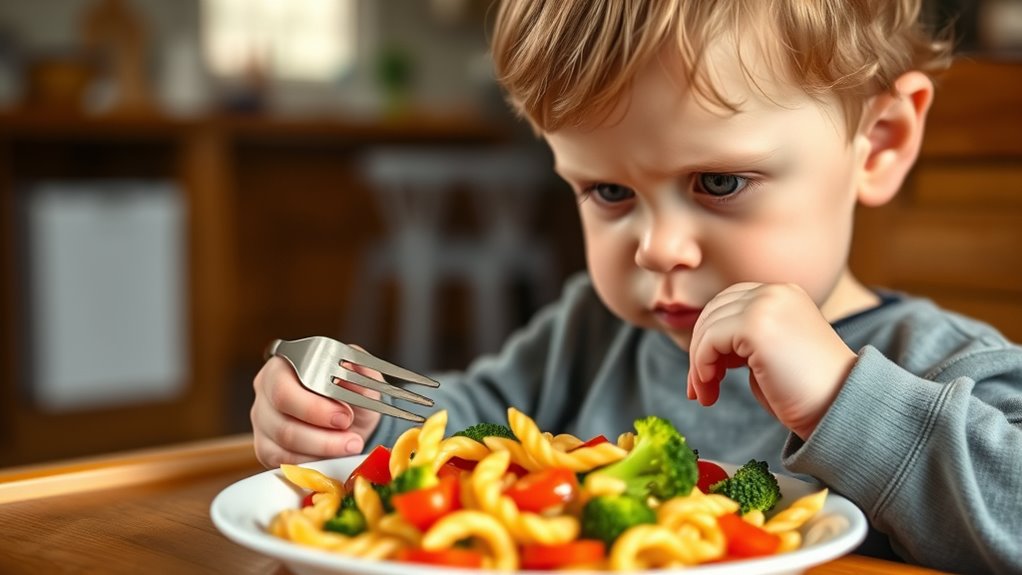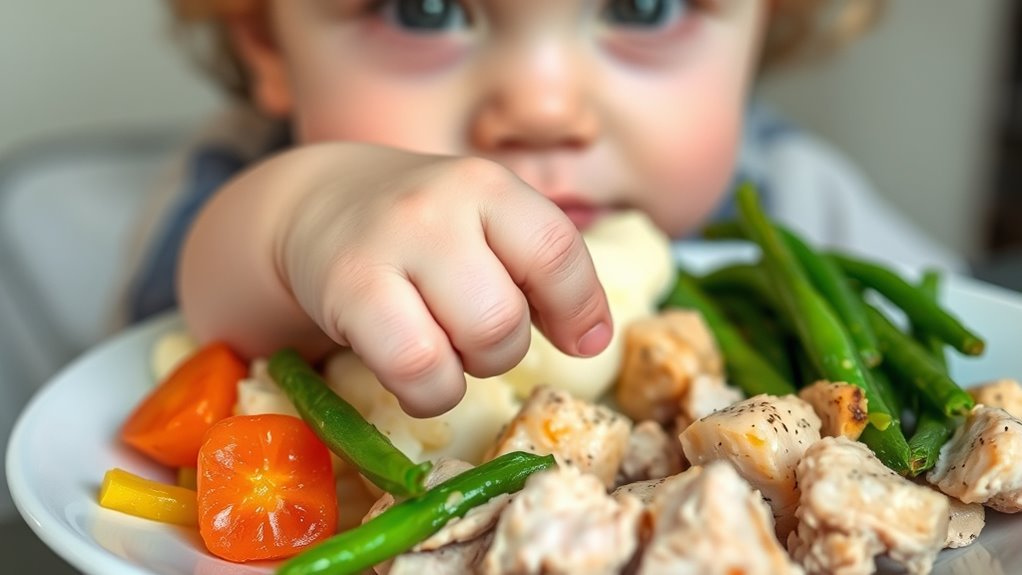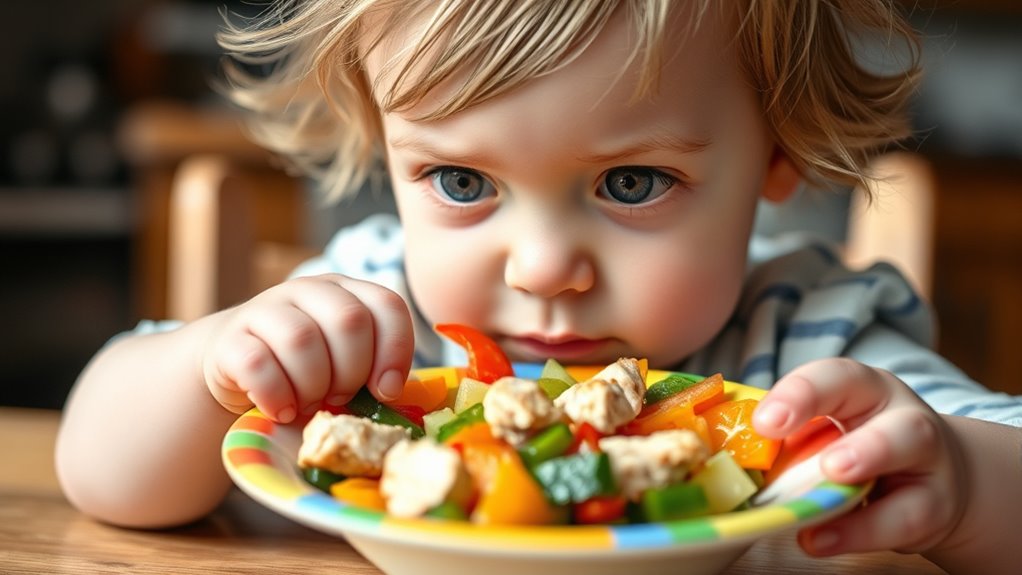Picky eating in toddlers often stems from developmental milestones, sensory sensitivities, and their desire for independence, causing food refusals and texture issues. Stress, emotional factors, and medical conditions can also play a role. To encourage diverse eating, focus on creating a positive mealtime environment, involve your child in food prep, offer choices, and stay patient. Keep exploring these causes and solutions to help your little one develop healthier eating habits.
Key Takeaways
- Picky eating during toddler years often relates to developmental stages, food neophobia, and sensory sensitivities.
- Medical conditions like allergies or reflux can cause food refusal, requiring proper diagnosis and management.
- Growth spurts and appetite fluctuations are normal, so avoid pressuring children during these phases.
- Creating a calm, positive mealtime environment and involving toddlers in cooking encourages diverse eating habits.
- Respecting independence, offering choices, and using positive reinforcement help reduce mealtime struggles.
Developmental Stages and Food Preferences

Understanding the developmental stages of toddlers can help explain their evolving food preferences. During this time, their taste development is rapidly changing, influencing what they enjoy and accept. Early on, children are naturally cautious about new foods, often refusing unfamiliar tastes. This is a normal part of their growth and often linked to limited food exposure. The more varied foods you offer, the more their taste buds become accustomed to different flavors. Repeated, gentle exposure to healthy options can gradually increase acceptance. Keep in mind that their preferences may shift frequently as they grow and explore. Patience is key; consistent, positive food exposure encourages broader tastes and helps them develop a balanced palate over time. Additionally, understanding food neophobia can help caregivers better navigate their child’s reluctance to try new foods. Recognizing that sensory sensitivities can also influence their food choices may help in creating a more accommodating eating environment. Being aware of childhood development milestones can further guide parents in understanding typical eating behaviors at different ages.
Sensory Sensitivities and Texture Aversion

Sensory sensitivities often play a significant role in a toddler’s picky eating habits, especially when it comes to textures. Many toddlers develop a texture aversion, avoiding foods that feel unfamiliar or uncomfortable in their mouths. Sensory sensitivities heighten their awareness of food qualities like crunchiness, sliminess, or firmness, making certain textures intolerable. You might notice your child rejecting foods with specific textures, even if they previously enjoyed them. This reaction isn’t about taste but sensory input. To support your toddler, offer foods with different textures gradually, and don’t force acceptance. Respect their sensory boundaries, and create positive experiences around eating. Establishing comfort solutions can help reduce their resistance to certain textures. Creating a calm eating environment can also lessen sensory overload and help them feel more at ease during meals. Additionally, understanding sensory processing can aid in identifying the root causes of their aversions. Over time, their sensory sensitivities may diminish, allowing them to become more open to a variety of textures.
The Impact of Independence and Control

Your toddler’s desire for autonomy often leads them to resist authority, especially around mealtime. They want to make their own choices and may reject foods they don’t select themselves. Understanding this drive can help you find ways to encourage healthy eating without stifling their need for control. Incorporating home decoration inspiration that creates a positive and inviting environment can also make mealtime more appealing and support their independence. Creating a therapeutic environment can help reduce mealtime stress and promote better eating habits. Recognizing the importance of relationship patterns can help you foster a supportive and encouraging atmosphere during mealtime.
Desire for Autonomy
As toddlers begin to recognize their own preferences, they often assert their desire for autonomy by resisting certain foods or insisting on doing things their way. This is a natural part of developing independence and self confidence. They want to make choices, including what and how they eat. Encouraging independent decision making helps them feel in control and supports self directed eating. You might notice them rejecting foods they once enjoyed or wanting to serve themselves. Instead of forcing, offer options and let them choose between healthy choices. This respect for their autonomy fosters trust and reduces power struggles around mealtime. Remember, their desire for independence is a sign of healthy growth, so supporting their need for control can lead to better eating habits over time. Recognizing dog names that suit their evolving personality can also help reinforce their sense of autonomy and confidence. Understanding size restrictions for tiny houses can provide insight into setting appropriate boundaries and expectations as they develop independence. Additionally, understanding the importance of developmental milestones can help caregivers support their child’s growing desire for autonomy in appropriate ways.
Resistance to Authority
Toddlers often resist authority as a natural expression of their desire for independence and control. They may refuse to eat certain foods or follow instructions simply to assert themselves. To manage this, setting boundaries is essential, but it’s equally important to offer choices. Giving choices like “Would you like carrots or peas?” empowers your child while maintaining your authority. This approach helps reduce power struggles and encourages cooperation. Be consistent with boundaries, so your toddler knows what to expect, but remain flexible enough to accommodate their need for control. Remember, resistance isn’t about defiance but about testing limits. By balancing firm boundaries with opportunities for choice, you help your toddler develop independence in a healthy, controlled way. Incorporating positive reinforcement strategies can also motivate your child to cooperate more willingly. Understanding the importance of consistent boundaries supported by clear communication can further ease these transitions. Recognizing the role of parental consistency can make a significant difference in managing resistance effectively.
Environmental and Mealtime Dynamics

The environment and mealtime dynamics play a crucial role in shaping a toddler’s eating habits. Consistent mealtime routines help your child feel secure and understand what to expect, reducing anxiety around eating. Creating a calm and distraction-free eating environment encourages focus on the meal, making it easier for your toddler to try new foods. Avoid pressuring or forcing them to eat, as this can increase resistance. Instead, serve meals in a comfortable setting with minimal noise and interruptions. Keep mealtime predictable and positive, offering a variety of healthy options without overloading your child. By establishing supportive mealtime routines and an inviting eating environment, you foster better eating habits and reduce picky tendencies over time.
Influence of Family Eating Habits

Family eating habits considerably influence a toddler’s relationship with food. Your family’s meal routines shape how your child views eating, whether as a positive experience or a source of conflict. Consistent routines, like sitting together for meals and offering a variety of foods, help create a sense of stability and encourage healthy eating habits. Sibling influence also plays a significant role; if older siblings enjoy a range of foods, your toddler is more likely to try them too. Conversely, if mealtimes are hurried or restrictive, your child’s picky tendencies might strengthen. By modeling healthy eating behaviors and establishing predictable routines, you can foster a more positive attitude toward food, helping your toddler overcome picky eating patterns. Volkswagen Tuning can serve as an analogy for the importance of consistent and positive modifications in establishing healthy habits. Additionally, the influence of family eating routines is similar to electric bike features, where the consistency and quality of components impact overall performance and habits. Recognizing the role of family dynamics in shaping eating behaviors emphasizes the importance of a supportive environment in overcoming picky eating.
Growth Spurts and Appetite Fluctuations

During growth spurts, your child’s appetite can change dramatically, making mealtime unpredictable. These periods are part of normal growth patterns, causing significant appetite changes that can leave you puzzled. You might notice your toddler eating less one day and craving more the next. Recognizing these patterns helps you avoid unnecessary concern or pressure. Understanding this fluctuation can also be an opportunity to introduce healthy eating habits and sustainable snack options that support healthy development. Additionally, monitoring stool patterns can provide insight into your child’s overall health during these fluctuating phases.
Stress and Emotional Factors

Stress can substantially affect your toddler’s appetite, making mealtime more challenging. Emotional triggers, like tantrums or changes at home, often lead to picky eating or food refusal. Anxiety around eating can also influence your child’s food choices, sometimes causing them to avoid certain textures or flavors.
Stress Impact on Appetite
When a toddler experiences emotional distress or feels overwhelmed, their appetite can decrease markedly. Stress related appetite often diminishes as their body reacts to anxiety or tension. This can lead to refusal of meals or snacks, making mealtime stressful for both of you. Emotional eating might also occur later, where your child seeks comfort through food, but during stress, appetite typically drops. Understanding this connection helps you stay patient during these phases.
- Stress can suppress hunger, causing your child to skip meals
- Emotional factors may lead to unpredictable eating patterns
- Recognizing stress signals prevents unnecessary worry about picky eating behaviors
Emotional Eating Triggers
Emotional factors such as anxiety, frustration, or fatigue can substantially influence a toddler’s eating habits. When your child feels overwhelmed or tired, they might turn to bedtime snacking as a comfort or distraction. These emotional cues can also be influenced by peer influence; if they see friends eating certain foods or snacking at playdates, they may imitate these behaviors to fit in or seek reassurance. Sometimes, stress triggers a desire for quick comfort foods rather than nutritious options. Recognizing these emotional triggers helps you respond calmly, offering soothing routines or alternative activities instead of relying on food. By understanding that emotions play a crucial role, you can better manage your toddler’s eating patterns and reduce unnecessary emotional eating.
Anxiety and Food Choices
Anxiety can strongly influence a toddler’s food choices, often leading them to seek comfort in certain snacks or refuse meals altogether. Childhood anxiety may cause food avoidance, as your child associates eating with stress or discomfort. When they’re overwhelmed, mealtime becomes a battleground rather than an opportunity to nourish. You might notice your little one clutching a favorite snack as a safety net or turning away from new foods altogether. Recognizing these signs helps you understand their emotional struggles. To ease their anxiety, try creating a calm, predictable mealtime routine. Offer reassurance and avoid pressuring them to eat. Understanding the link between anxiety and food choices can help you support your toddler’s emotional well-being and gradually reduce food avoidance.
Medical Conditions and Food Intolerances

Medical conditions and food intolerances can substantially influence a toddler’s eating habits. If your child has a medical condition, such as allergies, reflux, or gastrointestinal issues, they might refuse certain foods to avoid discomfort or adverse reactions. Food intolerances, like lactose or gluten sensitivity, can cause symptoms such as stomach pain, bloating, or diarrhea, making your toddler wary of specific textures or tastes. These physical discomforts often lead to selective eating, as your child associates certain foods with unpleasant feelings. Recognizing these underlying issues is essential; consult with your pediatrician to identify any medical conditions or food intolerances that could be affecting your child’s appetite or willingness to eat. Proper diagnosis and management can help improve their eating patterns over time.
Strategies to Encourage Diverse Eating

You can encourage your toddler to try new foods by making mealtimes fun and engaging. Offering small portions helps prevent overwhelm and builds curiosity, while involving your child in food prep can boost their interest in eating. These simple strategies can make diverse eating a positive experience for both of you.
Make Food Fun
Making food fun can turn mealtime into an exciting adventure for your toddler. Use colorful plating and playful presentation to grab their attention and spark curiosity. Kids are naturally drawn to bright, visually appealing foods, so incorporate vibrant vegetables and fruits into their plates. Get creative by arranging foods into fun shapes or characters, making each meal feel like a game. You can also involve your child in the process, letting them help with choosing colors and arranging their food. These simple tricks make eating more engaging, encouraging your toddler to explore new flavors and textures with enthusiasm. Remember, the goal is to create positive associations with mealtime, making it a joyful experience rather than a chore.
Offer Small Portions
Offering small portions can help your toddler feel more comfortable trying new foods. Start with miniature servings to avoid overwhelming them and to make the experience less intimidating. When you practice portion control, your child is more likely to focus on the taste and texture rather than feeling pressured by a large plate. This approach encourages exploration and reduces food waste, as they’re more willing to sample different options without feeling overwhelmed. Keep in mind, toddlers have small stomachs, so serving modest amounts ensures they stay interested and avoid feeling full too quickly. Over time, gradually increase portion sizes as your child becomes more open to trying a variety of foods. Small portions build confidence and foster a positive eating environment.
Involve Kids in Prep
Getting children involved in meal preparation can considerably boost their interest in trying new and diverse foods. When they help with meal planning and grocery shopping, they feel a sense of ownership and curiosity about what’s on their plate. Letting them pick out vegetables or choose between healthy options makes them more likely to taste what they’ve helped prepare. You can also involve them in simple tasks like washing produce or stirring ingredients, making the process fun and educational. This hands-on approach not only teaches them about different foods but also reduces picky eating tendencies. Engaging kids in the kitchen fosters a positive attitude toward diverse eating habits and builds confidence in trying unfamiliar dishes. It’s a practical way to turn mealtime into an enjoyable learning experience.
Creating a Positive Mealtime Environment

Creating a positive mealtime environment is essential for encouraging healthy eating habits in toddlers. Consistent mealtime routines help your child feel secure and prepared, making them more receptive to trying new foods. Use positive reinforcement to praise their efforts, not just their choices, fostering confidence. Keep distractions minimal, and focus on calm, cheerful interactions. Establishing a routine and rewarding progress creates a supportive atmosphere that reduces fussiness. Here’s what it looks like:
| Mealtime Routines | Positive Reinforcement |
|---|---|
| Consistent schedule | Praise small successes |
| Calm atmosphere | Smile and encourage |
| No pressure to eat | Use gentle words |
| Family meals together | Celebrate trying new foods |
| Limited distractions | Reward effort, not just taste |
Frequently Asked Questions
When Should I Be Concerned About My Toddler’s Picky Eating?
You should be concerned about your toddler’s picky eating if they consistently refuse to eat a variety of foods, especially protein and fruits, or show signs of poor growth. Watch for symptoms like weight loss or delays in development. Also, if you notice allergic reactions or suspect food allergies, consult your pediatrician. Addressing these issues early helps guarantee your child gets proper nutrition and supports healthy growth.
Can Picky Eating Affect My Child’s Nutritional Health Long-Term?
Yes, picky eating can impact your child’s long-term nutritional health. If they consistently avoid nutrient-rich foods, they might develop nutritional deficiencies, which can affect their growth and development. Over time, these deficiencies could lead to growth delays or other health issues. It’s important to encourage balanced eating habits early on, offering a variety of foods and consulting a pediatrician if you’re worried about their nutritional intake.
Are There Specific Foods to Avoid During Picky Eating Phases?
You should avoid giving your toddler foods that pose choking hazards, like whole nuts or grapes, during picky eating phases. Also, steer clear of foods they might be allergic to if they have known allergies, to prevent reactions. Instead, offer safe, nutrient-rich options like cooked vegetables or soft fruits. Keep an eye on their responses and consult your pediatrician if you’re unsure about which foods to avoid.
How Can I Handle Mealtime Battles Effectively?
Mealtime battles can feel like a never-ending storm, but you can navigate them with patience. Use effective mealtime strategies like offering small, colorful portions and involving your toddler in choosing foods. Stay calm and consistent, and celebrate even tiny successes with positive reinforcement. Remember, your calmness and persistence teach your child healthy eating habits, turning mealtime struggles into opportunities for connection and growth.
Does Picky Eating Indicate Underlying Behavioral Issues?
Picky eating doesn’t necessarily mean there are behavioral triggers or developmental milestones being skipped. It’s common for toddlers to go through phases of food preferences as they explore independence and new tastes. While some behaviors may hint at underlying issues, most picky eating is a normal part of development. Keep offering a variety of healthy options and avoid pressuring, helping your child develop healthy eating habits over time.
Conclusion
Understanding why your toddler is a picky eater helps you navigate mealtimes with patience. Remember, about 80% of children go through phases of food refusal, which is normal. By creating a positive environment and offering diverse foods without pressure, you can help your child develop healthy eating habits over time. Stay consistent, stay patient, and celebrate small successes—your persistence will pay off in their long-term relationship with food.









